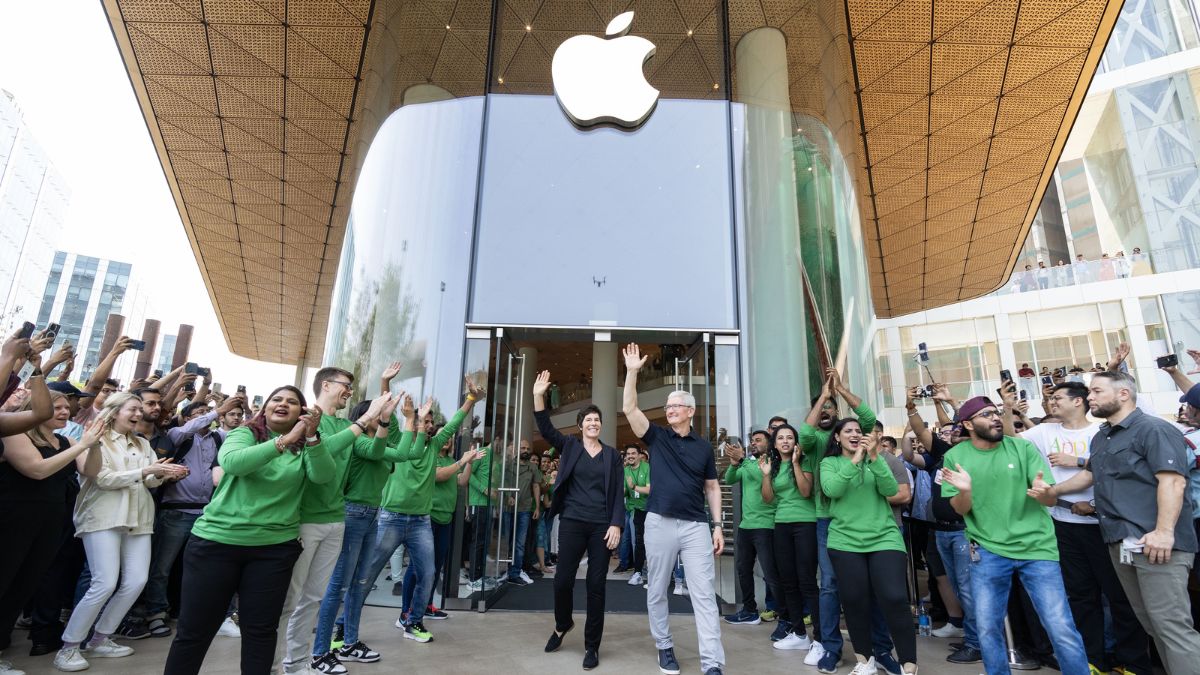Explainer: Trump’s iPhone googly and why Indians needn’t worry
 (File) Apple CEO Tim Cook opens the first Apple Store in India at Mumbai BKC in April 2023 | @tim_cook/X
(File) Apple CEO Tim Cook opens the first Apple Store in India at Mumbai BKC in April 2023 | @tim_cook/X
Donald Trump’s India-bashing continues, the latest being his threat to levy 25 per cent tariffs on iPhones imported into the US. But by now, it seems Donald Trump may just have overplayed his hand, with a transactional ‘bargaining chip’ pattern becoming pretty evident in his supposed randomness.
The only thing that has kept pace with Donald Trump’s tariff slapping, has been his flip-flopping, going back on announcements he had made earlier. Globally, he went back on his tariff announcements of April 2 so many times already that even experts have lost count—from a three-month moratorium to punitive duties up to 145 per cent on China, then an early deal with Beijing, to slapping an additional 25 per cent on Steel and aluminium, to threatening taxes on services and pharma to electronics, the man has marauded through the global economic system in less than 45 days.
ALSO READ | Will India get a full reciprocal tariff exemption from US? Interim trade deal negotiations in final stages
Same with India. After poking the Indian elephant over the past fortnight or so, first claiming credit for the India-Pakistan ceasefire, then going back on it, then saying India agreed only after threats of a trade boycott, and then quipping maybe that wasn’t the case, Trump has gone back and forth on many statements.
Now the latest, his targeting of Apple’s manufacturing of iPhones in India, may seem a bit more consistent—he’s made two direct threats, the latest last night even when he specifically spoke of a 25 per cent duty he will impose on iPhones manufactured in India or anywhere else other than the US. He later expanded it to include any phone brand manufactured outside of the US.
Let us examine the facts. Have you heard of Librem 5 USA? It’s a smartphone model made by a company called Purism, which says it is the only smartphone manufactured in the US. All the top-selling brands in the world, from Samsung Galaxy to Apple iPhone to the Vivos and Oppos of the world, are made in China and India, primarily.
Now Trump calling these companies to make in the US makes great political sense—he got elected on a plank of ‘Make America Great Again’ and cutting out the trade imbalances that he made his American working class base believe was doin’ them bad is a great political move. So, to threaten Apple, as well as others, that they should make in the US fits right in with that narrative, as it throws up the vision of thousands of new jobs for Americans.
Only, it simply may not come to pass.
Let’s explain. The very reason global manufacturing shifted primarily to China but also to places like Bangladesh when it came to textiles and component manufacturing in places like Vietnam and Thailand was because labour and raw materials are cheaply available here. As per a JP Morgan analysis, shifting iPhone assembly from China to India increases the cost by 2 per cent; but if you shift it to the US, the cost could go up by 30 per cent. This means Apple’s profits would fall seven and a half times if the iPhone is made in the US—remember, it is a listed company, and the management team led by Tim Cook is answerable to shareholders by now used to nice dividends and profits running into billions of dollars.
ALSO READ | Thanks to Trump’s tattles, India hitches its wagon to the EU free-trade deal
But instead, making the phone in India and incurring the 25 per cent would still be cheaper than making the phone in the US for the company. It will be easier, too, since most of the supply chain of components that go into this smartphone come from places like Taiwan, Korea, Japan, etc.
There are chips from the US, of course, but the larger number of components in the supply chain are in Asia, and shifting them to the US will be logistically complex and take years, not to forget the operative word, way more expensive.
And for what? For a phone whose cost might increase from the present 1,000 dollar average to even more than 2,000 dollars, and we are talking of the base model only?
And don’t forget, India does offer a production-linked incentive. This helps Apple save hundreds of crores of rupees right now.
Does Donald Trump now know all this? He does. In fact, if you notice his pronouncements, they are more bargaining chips than gospel truths. For example, the threat to impose a tariff on phones also came with a threat of a 50 per cent tariff on all goods from the EU—it came hours before the two sides were to meet for trade talks.
Similarly, earlier statements against India came just before Indian and US delegations sat down in Washington, D.C., to discuss their under-works Bilateral Trade Agreement.
In fact, some even believe that Trump’s statements against Apple shifting to India were also an overture to enemy-turned-friend China. Do note that both countries reached an early agreement on tariffs, curiously coinciding with Trump’s start of mouthing statements against iPhone shifting (away from China), though he cloaked it as a call for the very unlikely shift of manufacturing to the US.
Business